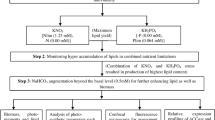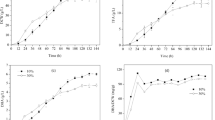Abstract
ATP-citrate lyase (ACL) is the key cytoplasmic enzyme which supplies acetyl-CoA for fatty acids in oleaginous yeast. Although it has been suggested that fatty acid and carotenoid biosynthesis may have a common source of acetyl-CoA in Phaffia rhodozyma, the source for carotenoids is currently unknown. The purpose of this work was to analyze the development of ACL activity during batch cultures of P. rhodozyma under ammonium-limited and nonammonium-limited conditions and study its possible relationship with carotenoid synthesis. Every experiment showed carotenoid accumulation linked to an increasing ACL activity. Moreover, the ACL activity increased with dissolved oxygen (DO), i.e., ACL responded to DO in a similar way as carotenoid synthesis. Additionally, in the ammonium-limited culture, ACL activity increased upon ammonium depletion. However, the contribution to carotenoid accumulation in that case was negligible. This suggests that P. rhodozyma has developed two components of ACL, each one responsive to a different environmental stimulus, i.e., DO and ammonium depletion. The role of each component is still unknown; however, considering that the former responds to DO and the known role of carotenoids as antioxidants, it may be a provider of acetyl-CoA for carotenoid synthesis.


Similar content being viewed by others
References
An GH, Schuman DB, Johnson EA (1989) Isolation of Phaffia rhodozyma mutants with increased astaxanthin content. Appl Environ Microbiol 55:116–124
Andlid T, Larsson C, Liljenberg C, Marison I, Gustafsson L (1995) Enthalpy content as a function of lipid accumulation in Rhodotorula glutinis. Appl Microbiol Biotechnol 42:818–825
Bhosale P (2004) Environmental and cultural stimulants in the production of carotenoids from microorganisms. Appl Microbiol Biotechnol 63(4):351–361
Bhosale P, Bernstein PS (2005) Microbial xanthophylls. Appl Microbiol Biotechnol 68(4):445–455
Boulton CA, Ratledge C (1981) Correlation of lipid accumulation in yeast with possession of ATP:citrate lyase. J Gen Microbiol 127:169–176
Cannizzaro C, Christensen B, Nielsen J, Stockar UV (2004) Metabolic network analysis on Phaffia rhodozyma yeast using C-13-labeled glucose and gas chromatography-mass spectrometry. Metabolic Eng 6(4):340–351
Dufosse L (2006) Microbial production of food grade pigments. Food Technol Biotechnol 44(3):313–321
Evans CT, Scragg AH, Ratledge C (1983) Regulation of citrate efflux from mitochondria of oleaginous and non-oleaginous yeast by adenine nucleotides. Eur J Biochem 132:609–615
Fell JW, Blatt GM (1999) Separation of strains of the yeast Xanthophyllomyces dendrorhous and Phaffia rhodozyma based on rDNA, IGS and ITS sequence analysis. J Ind Microbiol Biotechnol 23:677–681
Flores-Cotera LB, Martin R, Sánchez S (2001) Citrate, a possible precursor of astaxanthin in P. rhodozyma: influence of varying levels of ammonium, phosphate and citrate in a chemically defined medium. Appl Microbiol Biotechnol 55(3):341–347
Fraser PD, Miura Y, Misawa N (1997) In vitro characterization of astaxanthin biosynthetic enzymes. J Biol Chem 272:6128–6135
Gornall AG, Bardawill CJ, David MM (1949) Determination of serum proteins by means of the biuret reaction. J Biol Chem 177:751–766
Gu WL, An GH, Johnson EA (1997) Ethanol increases carotenoid production in Phaffia rhodozyma. J Ind Microbiol Biotechnol 19:114–117
Johnson EA, Schroeder WA (1996) Biotechnology of astaxanthin production in Phaffia rhodozyma. In: Takeoka GR, Teranishi R, Williams PJ, Kobayashi A (eds) Biotechnology for improved foods and flavors. American Chemical Society, Washington DC, pp 39–50
Jones RP (1989) Biological principles for the effects of ethanol. Enz Microbial Technol 11(3):130–153
Kim W, Tabita FR (2006) Both subunits of ATP-citrate lyase from Chlorobium tepidum contribute to catalitic activity. J Bacteriol 188:6544–6552
Klionsky DT, Ohsumi Y (1999) Vacuolar import of proteins and organelles from the cytoplasm. Ann Rev Cell Dev Biol 15:1–32
Konz JO, King J, Cooney CL (1998) Effects of oxygen on recombinant protein expression. Biotechnol Prog 14:393–409
Lodato P, Alcaíno J, Barahona S, Niklitschek M, Carmona M, Wozniak A, Baeza M, Retamales P, Jimenez A, Cifuentes V (2007) Expression of the carotenoid biosynthesis genes in Xanthophyllomyces dendrorhous. Biol Res 40:73–84
Lopez S, Gancedo JM (1979) Effect of metabolic conditions on protein-turnover in yeast. Biochem J 178(3):769–776
Meyer PS, du Preez JC (1994) Astaxanthin production by a Phaffia rhodozyma mutant on grape juice. World J Microbiol Biotechnol 10:178–183
Miller GL (1959) Use of dinitrosalicylic acid reagent for determination of reducing sugar. Anal Chem 31:426–428
Nakano T, Kanmuri T, Sato M, Takeuchi M (1999) Effect of astaxanthin rich red yeast (Phaffia rhodozyma) on oxidative stress in rainbow trout. Biochim Biophys Acta 1426:119–125
Ratledge CA, Wynn JP (2000) Understanding microbial obesity. SIM 50(4):181–185
Ratledge C, Wynn JP (2002) The biochemistry and molecular biology of lipid accumulation in oleaginous microorganisms. Adv Appl Microbiol 51:1–51
SAS Institute Inc (1989) Statistic guide for personal computers. Version 6.04. SAS Institute, Inc., NC, USA
Schroeder WA, Johnson EA (1993) Antioxidant role of carotenoids in Phaffia rhodozyma. J Gen Microbiol 139:907–912
Schroeder WA, Johnson EA (1995) Singlet oxygen and peroxyl radicals regulate carotenoid biosynthesis in Phaffia rhodozyma. J Biol Chem 270:18374–18379
Schuller HJ (2003) Transcriptional control of nonfermentative metabolism in the yeast Saccharomyces cerevisiae. Current Gen 43(3):139–160
Sedmak JJ, Weerasinghe K, Jolly SO (1990) Extraction and quantitation of astaxanthin from Phaffia rhodozyma. Biotechnol Tech 4:107–112
Shashi K, Bachhawat AK, Joseph R (1990) ATP:citrate lyase of Rhodotorula gracilis: purification and properties. Biochim Biophys Acta 1033:23–30
Sreré PA (1959) The citrate cleavage enzyme. I Distribution and purification. J Biological Chem 234(10):2544–2547
Vries SD, Marres CAM (1987) The mitochondrial respiratory chain of yeast. Structure and biosynthesis and the role in cellular metabolism. Biochim Biophys Acta 895:205–239
Vustin MM, Belykh EN, Kishilova SA (2004) Relationship between astaxanthin production and the intensity of anabolic processes in the yeast Phaffia rhodozyma. Microbiology 73(6):643–649
Weatherburn MW (1967) Phenol-hypochlorite reaction for determination of ammonia. Anal Chem 39:971–973
Yamane Y, Higashida K, Nakashimada Y, Kakizono T, Nishio N (1997a) Astaxanthin production by Phaffia rhodozyma enhanced in fed-batch culture with glucose and ethanol feeding. Biotechnol Lett 19:1109–1111
Yamane Y, Higashida K, Nakashimada Y, Kakizono T, Nishio N (1997b) Influence of oxygen and glucose on primary metabolism and astaxanthin production by Phaffia rhodozyma in batch and fed-batch cultures: kinetic and stoichiometric analysis. Appl Environ Microbiol 63:4471–4478
Acknowledgements
The authors thank to Elvira Ríos-Leal for assistance in ethanol analyses and Fernando Maldonado-García and Jesus Vega-Estrada for and their expert technical assistance. The research was funded by the Department of Biotechnology and Bioengineering, Cinvestav.
Author information
Authors and Affiliations
Corresponding author
Rights and permissions
About this article
Cite this article
Chávez-Cabrera, C., Flores-Bustamante, Z.R., Marsch, R. et al. ATP-citrate lyase activity and carotenoid production in batch cultures of Phaffia rhodozyma under nitrogen-limited and nonlimited conditions. Appl Microbiol Biotechnol 85, 1953–1960 (2010). https://doi.org/10.1007/s00253-009-2271-6
Received:
Revised:
Accepted:
Published:
Issue Date:
DOI: https://doi.org/10.1007/s00253-009-2271-6




